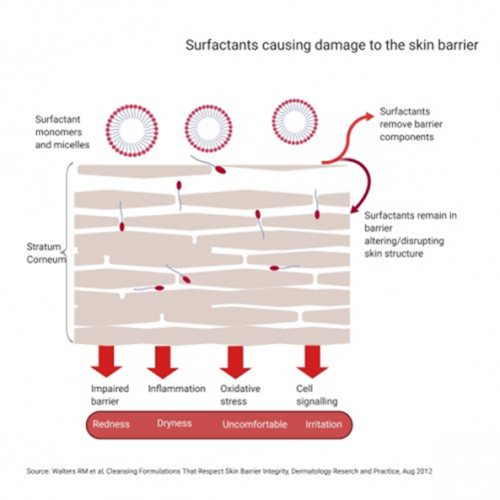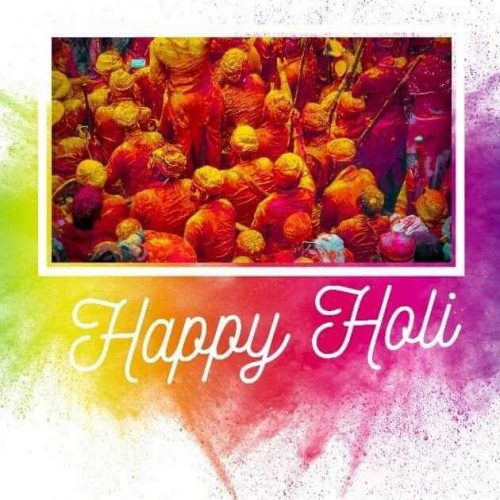*** This is a non-affiliated post. If I suggest a product, its based on my own personal use and/or wider experience/knowledge of products.***
Holi for me marks just over a year of living with COVID-19. We still haven’t reached herd immunity in most countries and nor have all our elderly relatives been vaccinated. Therefore, if you are planning to play Holi this year, please do safely.
Why do I need to prepare BEFORE I play Holi?
The main reason is you don’t want your skin barrier to be damaged. This diagram shows how skin barrier (both lipids and protenin) can be damaged by cleansing agents (surfactants) resulting in:
- Redness
- Dryness
- Irritation
- Uncomfortable skin

In essence, you want to avoid this because repairing the skin barrier takes time, effort and using the correct products.
Preparing skin, hair and nails before the event
Apart from discouraging bat sh*t crazy friends/family from attending, you can do the folllowing:
Hair: Oil your hair with coconut oil and your scalp and then make braids. This look may not be the most attractive, but It will save you a lot of heartache. If this does not appeal to you, then perhaps a baseball hat and/or tie your hair up in a bun helps.
Nails: For both your hands and feet, please use multiple coats (at least 3) of nail varnish and a top coat. I find the top coat prevents colour from seeping into my nails. For men, I would suggest a transparent nail varnish.
Body:
Cover your entire body from face to toe and then from toe to face in Vaseline. Its disgusting (I agree), but its your only friend here.
I don’t favour oil for the face to toe application because it gets absorbed into your skin. Also, some oils can block your pores causing break-outs, this is not the case with Vaseline which is non-comedogenic.
Vaseline is an occlusive and it essentially sits on your skin. The aim is for the colour to get trapped into the Vaseline before it reaches your skin.
Should you use sunscreen?
If you are expecting sunscreen to provide some formidable protection against UV AND you intend to play Holi, then let me disabuse you of that notion. As soon as water hits your skin and/or your wiping your face/body, the sunscreen becomes less effective and needs to be reapplied. I would simply forgo sunscreen that day and focus on sensible sun protection, including long-sleeve clothing, sunglasses and staying in the shade as much as possible.
How to remove colour after the event
Wipe off as much dry, excessive colour build up BEFORE you take a bath. Brush out as much colour from your hair as possible.
In terms of colour removal, this is my recipe which works better with castor or coconut oil. (In the past I have suggested olive oil, but castor oil really likes dirt and grim!).
For less stubborn stains, leave on for a couple of minutes and wash out GENTLY with a wet cloth. However, for stubborn stains leave on for at least 5 – 10 minutes. DO not let the pack dry out and again, gently wash out.
RECIPE
Combine the following to form a thick paste:
- 2 tbsp besan (or chickpea flour)
- Pinch of tumeric
- 2 tbsp castror oil (or another heavy oil)
- 1 tbsp honey
- 2 tbsp yogurt
1 tbsp is about 10 grams, so this should make a lot of paste. You need the honey because that’s the sticky element that will remove the Holi colour and because honey is a humectant – its going to prevent your skin from drying out.
How to calm your skin post Holi?
The best at-home option is moisturiser damp skin with organic coconut oil. If there is still much irritation on your face, then use aloe vera gel and fridge cold cucumber juice. I use Holland & Barrett’s aloe vera gel and Good Earth’s coconut oil.
Use a skin-barrier repairing moisturiser
If you need a heavy duty moisturiser for your skin (as your skin barrier may feel compromised), you can try out the following: La Roche-Posay Lipikar Baume AP+M. This has shea butter, glycerin and Niacinamide which are all fantastic for barrier repair. It cost £20 for 400ml.

Some of the benefits of Niacinamide include that it is more moisturising than White Petrolatum. (White Petrolatum is the most commonly used moisturiser for dry skin. It’s also the (informal) standard against which the performance of other moisturizers is assessed.)
The second and equally effective product is Bioderma’s Intensive Balm for sensitive skin. It costs £14.50 for 200ml. It has mineral oil, glycerin and sunflower seed oil. All of these are excellent moisturisers.

Topically applied glycerin restores Stratum Corneum hydration and you can read more in this blog The critical importance of glycerin in skincare
Other cheaper options…
If coconut oil is not an option for you, then shea butters from Juicy Chemistry are relatively cheap at INR 750. They are fragranced, but do the job of helping your skin retain moisture.
HAPPY SKIN DAYS. COPYRIGHT RESERVED 2021. I am a non-affiliated skincare blogger. I invest my own resources in researching and creating content for my blog. The contents of this blog, including images are protected by copyright law(s). My content cannot be replicated without my consent. You can write to me at email@happyskindays.com. I will file criminal and civil charges for copyright infringement.
